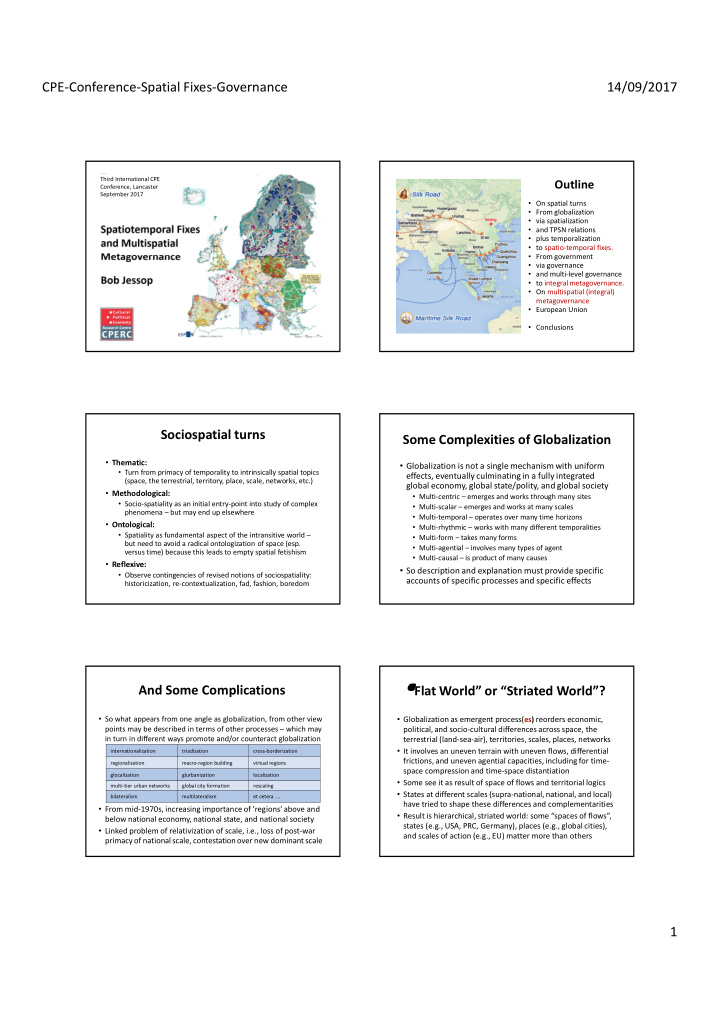



CPE-Conference-Spatial Fixes-Governance 14/09/2017 Third International CPE Outline Conference, Lancaster September 2017 • On spatial turns • From globalization • via spatialization • and TPSN relations • plus temporalization • to spatio-temporal fixes. • From government • via governance • and multi-level governance • to integral metagovernance. • On multispatial (integral) metagovernance • European Union • Conclusions Sociospatial turns Some Complexities of Globalization • Thematic: • Globalization is not a single mechanism with uniform • Turn from primacy of temporality to intrinsically spatial topics effects, eventually culminating in a fully integrated (space, the terrestrial, territory, place, scale, networks, etc.) global economy, global state/polity, and global society • Methodological: • Multi-centric – emerges and works through many sites • Socio-spatiality as an initial entry-point into study of complex • Multi-scalar – emerges and works at many scales phenomena – but may end up elsewhere • Multi-temporal – operates over many time horizons • Ontological: • Multi-rhythmic – works with many different temporalities • Spatiality as fundamental aspect of the intransitive world – • Multi-form – takes many forms but need to avoid a radical ontologization of space (esp. • Multi-agential – involves many types of agent versus time) because this leads to empty spatial fetishism • Multi-causal – is product of many causes • Reflexive: • So description and explanation must provide specific • Observe contingencies of revised notions of sociospatiality: accounts of specific processes and specific effects historicization, re-contextualization, fad, fashion, boredom And Some Complications “ Flat World” or “Striated World”? • So what appears from one angle as globalization, from other view • Globalization as emergent process( es) reorders economic, points may be described in terms of other processes – which may political, and socio-cultural differences across space, the in turn in different ways promote and/or counteract globalization terrestrial (land-sea-air), territories, scales, places, networks • It involves an uneven terrain with uneven flows, differential internationalization triadization cross-borderization frictions, and uneven agential capacities, including for time- regionalization macro-region building virtual regions space compression and time-space distantiation glocalization glurbanization localization • Some see it as result of space of flows and territorial logics multi-tier urban networks global city formation rescaling • States at different scales (supra-national, national, and local) bilateralism multilateralism et cetera …. have tried to shape these differences and complementarities • From mid-1970s, increasing importance of 'regions' above and • Result is hierarchical, striated world: some “spaces of flows”, below national economy, national state, and national society states (e.g., USA, PRC, Germany), places (e.g., global cities), • Linked problem of relativization of scale, i.e., loss of post-war and scales of action (e.g., EU) matter more than others primacy of national scale, contestation over new dominant scale 1
CPE-Conference-Spatial Fixes-Governance 14/09/2017 Territorial Sovereignty States and Politics • Globalization does not challenge The State: there is no • Different forms of territorialized political power co-exist and globalization in general and no state in general are complemented/ undermined by diverse forms of extra- • It has different meanings for, and impacts on, advanced territoriality in and beyond states • Overlapping modes of integration of world polity capitalist states, post-colonial states, post-socialist states, export-oriented developmental states, rentier (segmentation into states, centre-periphery, functional or non-territorial regimes) and hegemonic projects oil states, underdeveloped states, failed states, etc. • This opens space to study varieties of colonialism or imperialism, • Globalization affects territorial sovereignty in different world history, and variegated colonialism and/or imperialism as ways according to what is globalized, for example: structurally coupled, co-evolving forms of spatial organization • Trade - Financial flows • Capital accumulation (space of flows) is only one logic of • Portfolio Investment - Trade in derivatives organization of world market-world state-world society. • Direct investment - “Human capital” Other logics are possible: e.g., police-military security …. Terrestrial versus Territorial Problematizing Spatiality • The terrestrial refers to earth, water, and sky qua first • Space : “umbrella” term, substratum of other forms of nature and built environment (second nature) spatial differentiation and their associated, differentially selective opportunity structures for spatial strategies • Territorial as distinctive political form is not same as • Territory : territorialization of political power, tied to terrestrial as general substratum of this and other processes of bordering and territorial integration forms of socio-spatial organization • Scale : scalar hierarchy (dominant, nodal, subaltern), may be • Territory is result of political organization of the tangled, scope for creating/reordering/jumping scales terrestrial, i.e., constitution of frontiers, borders, limes • Place (or locale): specific locales in given terrestrial and/or that serve to ‘contain’ ( and connect) power territorial space (have temporal depth, tied to identities) • Terrestrial may be terra nullius and/or divided among • Network : forms of horizontal reticulation and connectivity territorial powers (“extra-territoriality”) among positions and places without regard to ‘borders’ Dimension of Principle of socio- Associated configurations of socio-spatial spatial structuration socio-spatial relations The TPSN Schema relations (spatialization) (aspects of spatial formats) Bordering, bounding, Construction of • The TPSN grid is an abstract taxonomic tool that can also be TERRITORY parcellization, inside/ outside divides, enclosure Constitutive role of outside populated by actual spatial imaginaries, representations, objects of strategic intervention, and (un)intended outcomes – a bridge between actors’ perspectives and observers’ interpretations Proximity, spatial Construction of spatial divisions of PLACE embedding, areal labour; horizontal differentiation in • Also useful for discussing different socio-spatial priorities of differentiation terms of core-periphery’ different accumulation regimes and modes of regulation: • North Atlantic Fordism prioritized territory and place (national Construction of scalar divisions of Hierarchization, economy-national state-national society plus efforts to reduce SCALE labor in terms of ‘dominant’,‘nodal’ Vertical differentiation regional uneven development due to Fordist growth dynamics) and ‘marginal’ scales • The knowledge-based economy prioritizes place and network (clusters, inserting places into world market, network-building) Interconnectivity, Networks of nodal ties • Finance-dominated accumulation prioritizes the telematic space of interdependence, Differentiate nodal NETWORKS flows over territory and promotes scalar networks of financial hubs) transversal or ‘rhizomatic’ points in topological networks differentiation 2
Recommend
More recommend